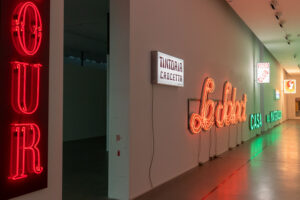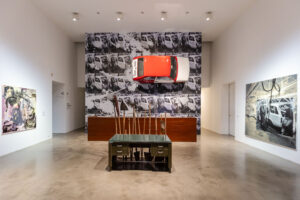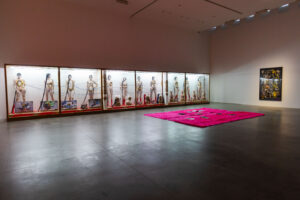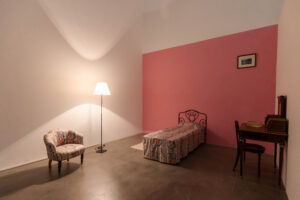Crossing the threshold of the Sandretto Re Rebaudengo Foundation, immediately to the left, one is plunged into a long corridor full of luminous signs so reminiscent of Parisian Pigalle, if one did not have the feeling of a much more recognisable and homegrown view with the imposing green and yellow ‘Mattress House’ sign towering over it.

Paulina Olowska, “Visual Persuasion”, 2023, 7 neon sculptures, courtesy the artist, Pace Gallery, London
The impression soon becomes a certainty as this colourful and immersive exhibition by Paulina Olowska, ‘Visual Persuasion’ in its first part leads the visitor into a colourful pop world where signs introduce elements from the consumer culture. The colourful neon lights are reminiscent of the cities in which the artist has lived, such as Paris, Chicago or Turin, and have the seductive power to attract and beguile with sibylline messages. In the powerful mix of colours and shapes, references to industrial production stand out with archive images of women in the Fiat assembly line, juxtaposed with sophisticated and elegant female images. The spatial juxtaposition between the two images, diametrically opposed with respect to their location in the Foundation’s premises, on the one hand, depicts a clear class differentiation, due to the blatant distinctiveness in the professions of the women represented but, on the other hand, basically portrays an independent and proud female figure who, in whatever way she is represented, whether through figurative art or photography, assumes the power of her autonomy in breaking free from the roles attributed to her by society. To be fair, although the exhibition is well orchestrated and the artist’s use of multiple mediums is effective, one cannot help but dwell on figurative art. It is in this sphere where Olowska renders the best of herself, both in terms of her mastery of the pictorial gesture and the strength and multiplicity of the women portrayed, who always convey an indomitable image of the protagonist described.

Paulina Olowska, “Tychy-Torino”, 2023, wallpaper, 7 x 5,8m, courtesy the artist
An example of this is the work ‘The philosophin’ (‘Verena in Vienna’) from 2023, where the modernity and pose of the subject, absolutely at ease in front of the chic shop window of a Viennese boutique, instil a feeling of freedom and autonomy in the subject, despite the minimalism of the features. “Visual Persuasion” takes its cue from the work of the same name by Stephen Baker, an advertising scientist and ethologist, who aimed to assess the influence of media techniques on the human subconscious. The approach, somewhere between the sociological and the mass-mediological, a classic from the 1960s, is fully grasped by Olowska, who builds around this concept, the incessant dialogue between her works and the others belonging to the Fondazione Sandretto Re Rebaudengo, which merge into a narrative unicum. The female imaginary and its multiple faces are then investigated with works of great significance for the exhibition, which question the role of women and their erotic imaginary. In Thomas Hirschhorn’s work entitled ‘Ingrowth’ (2009), disturbing mutilated mannequins denounce the violence of pornography for women, dialoguing with film clips from Julie Verhoeven’s ‘Your Fly is Open’ trilogy. On other screens, two professional dominatrixes, images from a horror porn film, somewhere between zoophilia and cannibalism and the film ‘Ecstasy’ by Olowska herself, in which references to the erotic fairy tale emerge overbearingly, disorient the visitor, raising various questions.

Thomas Hirschhorn, “Ingrowth”, 2009, wood, fluorescent lights, plexiglass, mannequins, toys, electric cables, prints, tape and clothes, 236 x 1300 x 100 cm, courtesy Fondazione Sandretto Re Rebaudengo, Torino
In the images of the room just described, the erotic imagery of women is shown as it has been perceived for years by the dominant male culture, even bordering on perversion. However, as Olowska herself has pointed out in various interviews on the subject of the exhibition, what is thought or deciphered about the erotic and pornographic imagery of women is not what women really imagine. Only in the last few years a feminist current, which has seen the emergence of concepts such as “body positivity”, claimed the autonomous and dominant role of women in sex, contrary to what had always been described. We have therefore witnessed the taking hold of a current of new militant feminism represented by writers and intellectuals who have taken part in the propagation of the message of women’s independence, despite the episodes of violence and feminicide to which she is still the subject.

Dominique Gonzalez-Foerster (b. 1965), “Hotel Color”, 1995, bed, armchair, desk, lamp, courtesy Fondazione Sandretto Re Rebaudengo, Torino
Precisely in the light of thinkers such as Eva Illouz or Tamara Tenenbaum, and linking up with the inspirational concept of the exhibition itself, the extent to which consumerist images feed the common imagination in labelling roles, questions arise as we walk through the exhibition. Indeed, we cannot help but wonder whether it might not have been more inspiring and powerful, in complete respect for the artist’s choice and representation, to show what women prefer, even on an erotic and pornographic level, rather than indulging in images that refer to commonplaces to be defeated. If the aim is to demolish the female gender stereotype and at the same time affirm the independence of women’s role in any exactly scheme, showing what is already known is certainly less transgressive than illustrating what still needs to be learnt.
Info:
Visual Persuasion
An exhibition by Paulina Olowska
2/11/2023 – 3/03/2024
With selected works from the Sandretto Re Rebaudengo’s Collection by: Tauba Auberbach, Vanessa Beecroft, Berlinde De Bruyckere, Trisha Donnelly, Peter Fischli and David Weiss, Sylvie Fleury, Nan Goldin, Dominique Gonzalez-Foerster, Mona Hatoum, Thomas Hirschhorn, Piotr Janas, Elena Kovylina, Barbara Kruger, Sherrie Levine, Sarah Lucas, Tracey Moffatt, Catherine Opie, Diego Perrone, Charles Ray, Cindy Sherman, Simon Starling and Richard Wentworth.
With works and contributions by : Maya Berezowska, Walerian Borowczyk, Pat Dudek, Irini Karayannopoulou, Sylvere Lotringer e Julie Verhoeven
Curatorial Coordination: Irene Calderoni
Fondazione Sandretto Re Rebaudengo
Via Modane, 16, Torino
fsrr.org

Globetrotter, passionate about literature, lover of art and photography. I never leave for a trip without taking with me a book by an author of the place where I will go. I have dreamed of moving to Paris for years and sooner or later I will!






NO COMMENT